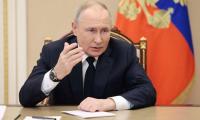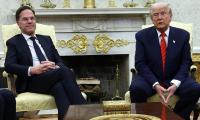Should former prime minister Nawaz Sharif agree to have an Implantable Cardioverter-Defibrillator (ICD) or a backup pacemaker implanted to regulate his heartbeat, as reportedly recommended by doctors and subsequently tweeted by his daughter Maryam Nawaz, he will enter the exclusive club of illustrious global personalities who have either benefited from these devices in the past or are still benefitting from them to “keep their hearts in check.”
What are Pacemakers and ICDs?
People having any disorder of heart rate or rhythm need a cardiac pacemaker or an implantable Cardioverter defibrillator implanted in their chests or abdomens.
When the heart beats too quickly, too slowly, or with an irregular pattern, the phenomenon is commonly called Arrhythmia.
According to the "American National Library of Medicine," which is operated by the United States Federal government with a budget of over $341 million, a Pacemaker helps control abnormal heart rhythms. It uses electrical pulses to prompt the heart to beat at a normal rate. It can speed up a slow heart rhythm, control a fast heart rhythm, and coordinate the chambers of the heart.
The Maryland-based "American National Library of Medicine," founded in 1836, further states that an ICD, on the other hand, monitors heart rhythms. If it senses dangerous rhythms, it delivers shocks. This treatment is called "Defibrillation."
An ICD can thus help control life-threatening Arrhythmias, especially those that can cause Sudden Cardiac Arrest or CSA.
Most new ICDs can act as both a Pacemaker and a defibrillator. Many ICDs also record the heart's electrical patterns when there is an abnormal heartbeat. This can help the doctor plan future treatment.
Getting a pacemaker or ICD requires a minor surgery. Patients usually need to stay in the hospital for a day or two, so that their respective doctor can make sure that the device was working well.
The patients probably get back to their normal activities within a few days.
Here follows a brief list of eminent international leaders and other celebrities who have either had Pacemakers implanted in bodies or have been benefitting from the ICDs:
Former Italian Prime Minister and media tycoon, Silvio Berlusconi, former President of Israel, Reuven Rivlin, former American President, Gerald Ford, former Canadian Governor General, Adrienne Clarkson, former Crown Prince of Nepal, Paras Bir Bikram Shah Dev, leader of the Catholic Church, Pope Benedict XVI, former US Vice-President, Dick Cheney ( he had an implantable Cardioverter Defibrillator implanted in 2001), James Major, son of former British Prime Minister John Major, great female philanthropist, Mother Teresa, the star of James Bond movies from 1973 to 1985, Roger Moore (he had a pacemaker implanted on May 10, 2003), former Japanese Prime Minister, Keizo Obuchi, great American actor, producer and director, Kirk Douglas, former Manchester United soccer manager, Sir Alex Ferguson, renowned British singer, Sir Elton John, and American Senators Dianne Feinstein and Bob Dole etc.
By the way, the Pacemaker inventor, Dr. John Hopps (1919-1998), was fitted with one of these devices to regulate his heartbeat—some 27 years after having invented the first pacemaker in 1950.
However, Dr.Hopps died just before his invention was voted the Canadian engineering invention of the century. He is revered in Canada as the father of biomedical engineering. According to the 95-year old American Heart Association, an implantable Cardioverter-Defibrillator (ICD) is a device implantable inside the body, able to perform cardio version, defibrillation, and (in modern versions) pacing of the heart.
The American Heart Association, which has invested more than $4.1 billion in research since its inception in 1924, states that an ICD is a battery-powered device placed under the skin that keeps track of your heart rate.
Its website adds: “Thin wires connect the ICD to your heart. If an abnormal heart rhythm is detected the device will deliver an electric shock to restore a normal heartbeat if your heart is beating chaotically and much too fast.”
Research conducted by the American Heart Association further reveals that several types of devices and machinery may interfere with the Pacemakers and ICDs, as the electromagnetic waves generated by such devices can prevent these devices from functioning properly
These gadgets include newer models of certain cell phones because the wireless transmissions from their antennae might make ICDs and pacemakers less reliable. The wireless industry is investigating that possibility though.
The American Heart Association, assisted in its work of fighting heart diseases and strokes by more than 33 million volunteers and supporters as well as our more than 3,400 employees, recommends that cell phones should be kept at least six inches away from the ICD or pacemaker by using it on the ear opposite ear where your device has been implanted.
It strictly asks heart patients using these devices to avoid keeping their cell phones in their front chest pockets.
Similarly, walkie-talkies (operating on three watts or less) should be kept at least six inches away from the ICD or pacemaker implantation site.
MP3 players/headphones and IPods etc also pose a risk to pacemakers.
Most MP3 headphones contain a magnetic material that can interfere with ICDs and pacemakers.
The website of the American Heart Association further states:
Don’t allow someone wearing headphones to rest his or her head on your chest.
Don’t place headphones in your breast pocket.
Don’t drape headphones around your neck so that they hang on your chest.
Certain Citizen’s Band (CB) Radios, operating on 3 to15 watts, should be kept at least 12 inches from the ICD.
CB Radios operating on 15-30 watts should be kept at least two feet from the device.
If one is having an ICD or pacemaker, he or she should avoid close or prolonged contact with magnets or their magnetic fields.
Moreover, Metal detectors for security and Anti-theft systems (also called electronic article surveillance or EAS) may also interfere with the working of these devices under review.
Pharmacy Council of Pakistan building can be seen in this image. — pcpisb.gov.pk/FileIslamabad:The Pharmacy...
Federal Minister for Communications Abdul Aleem Khan presiding over a high-level National Highway Authority meeting...
A representational image of a police tape restricting an incident scene. — Reuters/FileIslamabad:In a tragic...
Federal Minister for Information Technology and Telecommunications Shaza Fatima Khawaja exchanging views with Khazar...
Federal Minister for Parliamentary Affairs Dr Tariq Fazal Chaudhry addresses an event on February 2, 2025. —...
This representational image shows teachers staging a protest rally and boycotting classes. — Facebook@Punjab...







